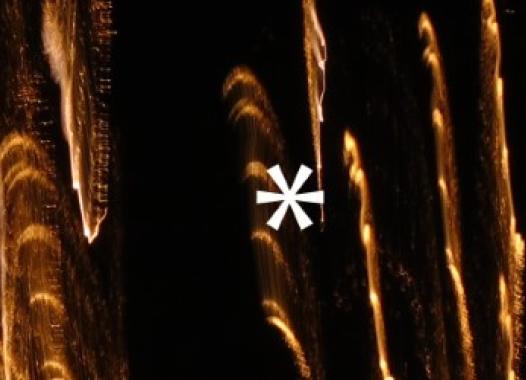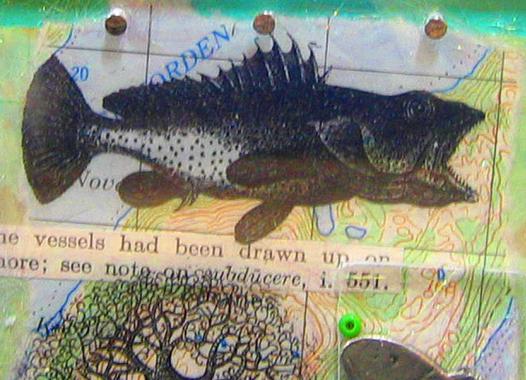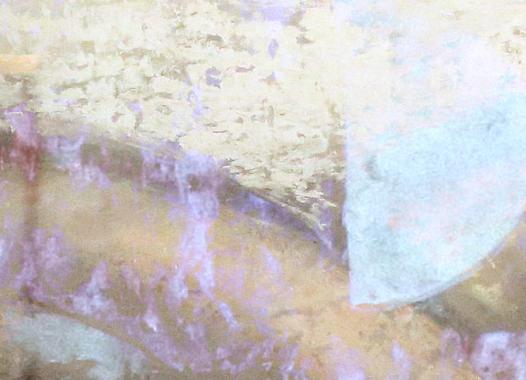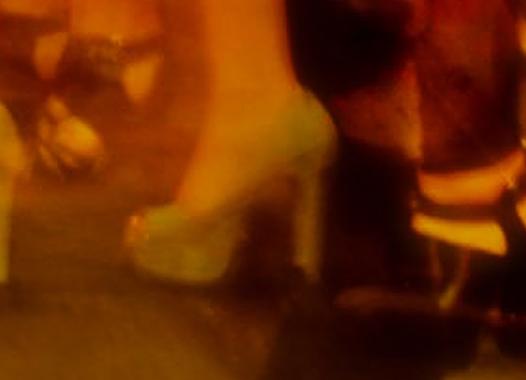
This is an excerpt from Sarah Ensor’s “Queer Fallout: Samuel R. Delany and the Ecology of Cruising”
In the final paragraph of his 2002 essay “Sociability and Cruising,” Leo Bersani concludes his discussion of impersonal intimacy and promiscuous attachments with an unexpected turn to ecology: “Let’s call this [ethical model predicated on ascetic practices] an ecological ethics,” he suggests, “one in which the subject, having willed its own lessness, can live less invasively in the world.”[1] Cited out of context, there is perhaps little surprising about this statement, particularly its final clause. Environmental stewardship, in its most familiar incarnations, often asks us to live less invasively – to “leave no trace,” to cite one popular backcountry adage, or to “take only pictures, leave only footprints,” to cite another. Ethical relationality is thus commonly predicated on restraint, on learning to make do with less, on compromising our acquisitive or consumptive desires for the sake of an often enigmatic – but protectively policed – “common good.” Yet queer theory challenges the foundations (and foundational status) of both that “common” and that “good”; invested not in chaste restraint but in polymorphous pleasures, not in the steadying pull of biological reproduction and its familiarly (and familially) accompanying “future generations” but in “the formation of new alliances and the tying together of unforeseen lines of force”;[2] and not in conserving or sustaining present ways of life but rather in rupturing or annihilating norms, the field seems to trouble and in fact endanger many of the tenets that environmentalists hold so dear.[3]
Certainly Bersani himself is not a theorist known for endorsing environmentalism’s familiar paradigms of responsibility and respectability; after all, this is the writer who, in Homos, opened a chapter by asking, skeptically, “Should a homosexual be a good citizen?” and then went on to suggest that “given the rage for respectability so visible in gay life today, some useful friction – and as a result some useful thought – may be created by questioning the compatibility of homosexuality with civic service.”[4] Furthermore, the practice at stake in this piece of Bersani’s – cruising – seems to signal the death knell for any reading of the essay as modeling an ecological ethic, regardless of its final turn. For the encounters involved in and resulting from cruising – stereotypically temporary, casual, anonymous – seem to have little in common with the practices associated with meaningful planetary stewardship.
But what if we took seriously Bersani’s casual remark and asked what the relationship may in fact be between cruising and environmentalism? In what follows, I seek less to account for Bersani’s claim[5] than to expand upon it, to ask how cruising might inspire an ecological ethic more deeply attuned to our impersonal intimacies with the human, nonhuman, and elemental strangers that constitute both our environment and ourselves.[6] To develop such a model, I look not only to Bersani’s work but also (and primarily) to Samuel R. Delany’s Times Square Red, Times Square Blue (TSRTSB), whose attention to the positive fallout of spontaneous cross-class contact, I claim, complicates the proprietary, insular, and paranoid logics prevalent in much popular environmental discourse. As Delany’s text brushes near Bersani’s and next to contemporary environmental writings (with which it might have more in common than either field is ready to acknowledge[7]), it limns the contours of a queer environmentalism predicated less on direct(ed) investment than on ambient affects, impersonal futures, and nonteleological practices of care. Ultimately, I will argue, in tracing how intimacy, impersonality, and consequence disperse throughout urban space and across various measures of time, Delany offers us new ways to understand the “politicized intimacy with other beings”[8] that constitutes contemporary ecological relations as such. The result is an environmental ethic that acknowledges the extent to which ecological entanglement resembles the queer relationality of cruising far more than it does the other (more normative) relational paradigms to which we so often analogize it.
Cruising’s Queer Ecology
Drawing on the work of sociologist Georg Simmel, Bersani’s essay rehearses the fundamental distinction between society, predicated on interests and identities, and sociability, in which an impersonal mode of being facilitates something akin to “pure relationality” and fosters the feeling “of association as such.”[9] Sociability, according to Bersani’s account of Simmel, “abstract[s] the relational from concrete relations,” granting us access to “the pleasure of the associative process,” to “a pure relationality” that dwells “beyond or before the satisfaction of particular needs or interests.”[10] While such bracketing of the personal – which, in Bersani’s account, entails the renunciation of both possession and any acquisitive impulse – requires a sacrifice, it is also “pleasurable,” its “satisfaction inherent”; for within sociability, each one of us, like the woman who becomes one of Simmel’s examples, is “‘not completely [one]self’” but rather “only an element in a formally constituted gathering.”[11] “It is as if there is a happiness inherent in not being entirely ourselves,” Bersani suggests, provocatively, “in being ‘reduced’ to an impersonal rhythm.”[12] And like the self, no longer driven by acquisitive impulse, this happiness or pleasure “does not serve an interest, satisfy a passion, or fulfill a desire. It is an intransitive pleasure intrinsic to a certain mode of existence, to a self-subtracted being.”[13]
Although cruising and sociability themselves are immanent, non-teleological practices, Bersani wishes his theorization of the terms to reach beyond itself; he insists that attending seriously to cruising “is not a question of demonstrating that certain outrageous practices are really taking place within the parameters of a traditional ethics, but rather of specifying the ways in which those practices may or may not require us to elaborate new ethical vocabularies.”[14] If one of the goals of the current essay is to pursue such an elaboration, it seems important to acknowledge that in many respects Delany has beaten us – and Bersani himself – to the punch. Although TSRTSB precedes “Sociability and Cruising” by three years, it often reads as a response to Bersani’s variously articulated challenges, not only in its articulation of “new ethical vocabularies” but also in its attention to ways of life – and forms of civic investment – predicated on the culture of cruising in the 42nd Street moviehouses and the peep shows of the “old” Times Square.[15]
Indeed, for Delany, eroticism, sexual contact, and open expressions of desire are fundamental to the democratic potential of the spaces in which we dwell. Throughout TSRTSB, he establishes the links – or, to use one of his own favorite terms, “propinquity” – between casual sexual contact and casual non-sexual encounters; while he is not invested in the nonhuman world per se (although, as my discussion will illuminate, the emphasis on ambient conditions in his conception of the cityscape puts him in implicit conversation with environmental thought), his thinking is ecological, insofar as it takes seriously the capacity of seemingly casual, localized, and contingent relational practices to circulate throughout the broader social milieu in which they transpire.[16] We thus might argue that TSRTSB theorizes a kind of sexual ecology, a term that I borrow from Gabriel Rotello, whose 1997 book of the same name has been deemed “the Silent Spring of the AIDS epidemic.”[17] Sexual Ecology analyzes AIDS as an ecological phenomenon, arguing that the “enemy” is not the disease itself but rather the conditions that facilitate its spread. Sexual ecology, as Rotello defines it, thus “consists of the entire spectrum of causes and effects that influence the spread of sexually transmitted diseases”[18]; as he goes on to insist, “[t]o begin the process of envisioning a sustainable gay lifestyle that can encourage gay liberation and avoid epidemic disease over the long haul, we have to learn to think ecologically about sex.”[19]
TSRTSB, I would argue, also helps us “learn to think ecologically about sex” – not, as Rotello would have it, by tracing the contextual contours of a sexually transmitted disease so as to limit its spread, but rather by revealing the way that intimacy, community, and care themselves spread in the spatiotemporal wake of casual sexual activity. Whereas Rotello’s response to HIV mandates a largely prophylactic and risk-averse approach to erotic life – including a commitment to monogamy and a reduction in cruising – Delany, inversely, advocates an embrace of contact, positing it as fundamental to the vitality not only of individual subjects but also, and more profoundly, of the urban environment itself. The difference between the writers’ approaches, then, might have repercussions not only for the status of cruising but also, importantly, for the orientation of environmental activism. If Rotello seeks to change casual sexual practice by aligning it with a chaste, “mature,” and restrained environmentalism, Delany, I want to suggest, can inspire a change in that same environmentalism by inviting it to attend to the impersonal, collateral, and insistently ambient effects of casual relationships.[20] Although Delany never directly engages ecology as such, his text is predicated upon close attention to “a complex of interlocking systems and subsystems,”[21] to the way in which “social interchanges of information and material occur in various forms of social nets,”[22] to how interclass contact becomes “the lymphatic system of a democratic metropolis.”[23] Ultimately, he encourages us “to look not so much at social objects and social monuments but to observe, analyze, and value a whole range of social relationships.”[24]
Among the social relationships that concern Delany is the relationship between practices of cruising – or public sex more generally – and the forms of spontaneous cross-class contact fundamental to the livability and democratic health of urban spaces. The distinction that Bersani (via Simmel) draws between society and sociability finds its analog in Delany’s differentiation between the roles that two forms of social-net practice – networking and contact – play in civic life. Networking, like society, is animated by interest, by identity, by motive – and often, consequently, by affinity or likeness. It “tends to be professional and motive-driven…. [It] crosses lines only in the most vigilant manner... [and] is heavily dependent on institutions to promote the necessary propinquity (gyms, parties, twelve-step programs, conferences…), where those with the requisite social skills can maneuver.”[25] Contact (a term that he adapts from the work of Jane Jacobs), by contrast,[26] is “more broadly social,” amenable to chance and surprise and difference alike:
Contact is the conversation that starts in the line at the grocery counter with the person behind you while the clerk is changing the paper roll in the cash register. It is the pleasantries exchanged with a neighbor who has brought her chair out to take some air on the stoop…. It can be the conversation that starts with any number of semiofficials or service persons – mailman, policeman, librarian, store clerk or counter person. As well, it can be two men watching each other masturbating together in adjacent urinals of a public john – an encounter that, later, may or may not become a conversation. Very importantly, contact is also the intercourse – physical and conversational – that blooms in and as “casual sex” in public rest rooms, sex movies, public parks, …on street corners with heavy hustling traffic, and in the adjoining motels or the apartments of one or another participant, from which nonsexual friendships and/or acquaintances lasting for decades or a lifetime may spring, not to mention the conversation of a john with a prostitute or hustler encountered on one or another street corner or in a bar – a relation that, a decade later, has devolved into a smile or a nod, even when (to quote Swinburne) “You have forgotten my kisses,/And I have forgotten your name.”[27]
Importantly, cruising here is just one example – if a privileged one – of the routine forms of spontaneous contact between strangers that Delany understands to have been compromised by the sanitizing “redevelopment” of Times Square and the privatization of urban space more broadly. Indeed, the rhetorical power of the passage consists in how scenes that we understand as constitutive of the daily culture of any American city come to touch the non-normative, “fringe” practices of public sex, and how scenes specific to 1980s New York burgeon within (or diffuse into) a more conventional portrait of American urbanity. The passage thus suggests not only that contact is what cruising becomes as it disperses across time, space, and publics to become a common way of life – but also that scenes of public sex, if not a prerequisite for these more familiar, banal encounters, nevertheless index contact’s own (im)possibility. At its best, Delany suggests, a city is a realm where we all find ourselves (knowingly or not) beckoned to cruise.
Thus the passage as a whole represents, in microcosm, the most powerful aspects of cruising’s queer ecology. First, we might notice the complicated temporality in which contact inheres. Meaningful – and fleeting – encounters typically take place in spaces of suspension. They happen “while the clerk is changing the paper roll in the cash register.” They happen as the neighbor takes a break on the stoop or as “semiofficials” forestall various responsibilities – expanding, however gently, the time of the task. They happen in the marginal furrows of society, in the space of “waste” and pleasure as opposed to the time of duty or (re)production. Indeed, whereas networking is instrumental (Delany’s paradigmatic example is writers angling for book deals at conferences), the future of contact is starkly impersonal: “I have forgotten your name.” Contact and cruising are realms in which anonymity and impersonality can be the ground of intimacy rather than barriers to it, where nonknowledge of our variably significant others can be a state that endures.
Likewise, rather than simply emphasizing the fleetingness of casual encounters, Delany’s account of cruising changes how longevity looks and feels. (What does it mean, his text often implicitly asks, for something to last?) Forgetting is invoked not as a sign of disappearance but as an indicator of persistence. Yoked together in Delany’s final sentence are the possibility of friendships “lasting for decades or a lifetime” and one-time encounters that have “devolved into a smile or a nod.” The lasting and the devolving are not opposed but rather are parts of the same sociosexual ecology. What they have in common, as other scenes from the book illustrate more fully, is the way in which they – the fading, the remaining, the devolving, the burgeoning – suffuse the spaces in which they take place, and make urban life livable.
At the same time that Delany’s points are insistent, they are also necessarily nonprogrammatic. For he advocates not particular identity categories, actions, or practices but rather a posture of openness to chance, a willingness to acknowledge that we cannot possibly know what will come of any given encounter. The passage above, perhaps unsurprisingly, is awash in language of contingency: not only the “may” and “may not” through which Delany traces the uncertain contours of consequence but also the repeated refrain “it can be,” which gestures toward the impossibility of predicting what forms contact might or will take. We cannot know in advance what will last or fade, how we may feel lasting traces of the fading, or how forgetting itself may become a form of relation. We do not know how what “devolve[s]” may still permeate our days – not as an absence experienced with longing or regret or melancholy but as a diminished persistence that, having become more part of our substance (and our surroundings) than of our memories, affects our daily experience of the world.
Thus while there is, importantly, nothing preordained about these beginnings – Delany permits himself to inhabit, to borrow the language of Eve Kosofsky Sedgwick (writing in a quite different context), “the present fullness of a becoming whose arc may extend no further”[28] – there is also nothing preventing them from yielding social consequence, direct or indirect. Part of the point is that these beginnings are typically not fraught with expectation; they are not the start of a familiar narrative but rather episodes open to and predicated on indirect effects. The paradigms of intimacy and relationality that concern Delany, not unlike the forms of environmental damage and slow violence cataloged by Rachel Carson and theorized by Rob Nixon, often are invisible until they reach a threshold of legibility.[29] We forget about many of those whom we encounter until we see them again on a street corner, until chance brings them back into our life narrative and begins to articulate the ways in which they may have been there – invisibly, anonymously, ambiently, materially – all along.
***
Acknowledgements
I would like to thank the Environmental Humanities editorial team, as well as two anonymous readers, for comments that helped me to clarify, refine, and extend the argument of this essay. I am grateful, too, to Ingrid Diran, Sarah Lincoln, Sarah Weiger, and my former colleagues and students at Portland State University, with whom I have discussed many of these ideas.
Bibliography
Alaimo, Stacy. “MCS Matters: Material Agency in the Science and Practices of Environmental Illness.” TOPIA no. 21 (Spring 2009): 9-27.
Bennett, Jane. Vibrant Matter: A Political Ecology of Things. Durham: Duke University Press, 2010.
Bersani, Leo. Homos. Cambridge, MA: Harvard University Press, 1995.
---------. “Sociability and Cruising” In Is the Rectum a Grave? and Other Essays, 45-62. Chicago and London: University of Chicago Press, 2010.
Bersani, Leo and Adam Phillips. Intimacies. Chicago: University of Chicago Press, 2008.
Biddle, Frederic M. “Grim Warning on AIDS in the 90s.” Boston Globe, July 23, 1997, D6.
Carson, Rachel. Silent Spring. New York: Mariner Books, 2002.
Chen, Mel Y. Animacies: Biopolitics, Racial Mattering, and Queer Affect. Durham, NC: Duke University Press, 2012.
Clark, Nigel. Inhuman Nature: Sociable Life on a Dynamic Planet. London: Sage, 2011.
Cohen, Jeffrey Jerome. Stone: An Ecology of the Inhuman. Minneapolis: University of Minnesota Press, 2015.
Delany, Samuel R. Times Square Red, Times Square Blue. New York: New York University Press, 1999.
Ensor, Sarah. “Spinster Ecology: Rachel Carson, Sarah Orne Jewett, and Nonreproductive Futurity.” American Literature 84, no. 2 (2012): 409-435.
Foucault, Michel. Friendship as a Way of Life.” In Ethics/Subjectivity and Truth, edited by Paul Rabinow, 135-140. New York: The New Press, 1997.
Halberstam, Judith. “Queer Temporality and Postmodern Geographies.” In In a Queer Time and Place: Transgender Bodies, Subcultural Lives, 1-21. New York: New York University Press, 2005.
Hoff Victor, and Senzee Thom. “Finding the Gay in Green: LGBTs and Enviromentalists Share a Lover.” LGBT weekly, April, 2017.
Iovino, Serenella and Serpil Opperman. “Material Ecocriticism: Materiality, Agency, and Models of Narrativity.” Ecozon@ 3, no. 1 (2012): 75-91.
----------. “Theorizing Material Ecocriticism: A Diptych.” ISLE: Interdisciplinary Studies in Literature and Environment 19, no. 3 (Summer 2012): 448-475.
Moore, Kathleen Dean and Michael P. Nelson, eds. Moral Ground: Ethical Action for a Planet in Peril. San Antonio: Trinity University Press, 2010.
Mortimer-Sandilands, Catriona and Bruce Erickson, “Introduction: A Genealogy of Queer Ecologies.” In Queer Ecologies: Sex, Nature, Politics, Desire, edited by Mortimer-Sandilands and Erickson, 1-47. Bloomington: Indiana University Press, 2010.
Morton, Timothy. “Guest Column: Queer Ecology.” PMLA 125, no. 2 (2010): 273-282.
---------. “Thinking Ecology: The Mesh, The Strange Stranger, and the Beautiful Soul,” Collapse 6 (January 2010): 265-293.
Muñoz, José Esteban. Cruising Utopia: The Then and There of Queer Futurity. New York: New York University Press, 2009.
Nixon, Rob. Slow Violence and the Environmentalism of the Poor. Cambridge, MA: Harvard University Press, 2011.
Nyong’o, Tavia. “Back to the Garden: Queer Ecology in Samuel Delany’s Heavenly Breakfast.” American Literary History 24, no. 4 (2012): 747-767.
Rotello, Gabriel. Sexual Ecology: AIDS and the Destiny of Gay Men. New York: Dutton, 1997.
Sedgwick, Eve Kosofsky. “Paranoid Reading and Reparative Reading, or, You’re So Paranoid, You Probably Think This Essay Is about You.” In Touching Feeling: Affect, Pedagogy, Performativity, 123-151. Durham, NC: Duke University Press, 2003.
Seymour, Nicole. Strange Natures: Futurity, Empathy, and the Queer Ecological Imagination. Urbana: University of Illinois Press, 2013.
Steingraber, Sandra. Raising Elijah: Protecting Our Children in an Age of Environmental Crisis. Philadelphia: Da Capo, 2011.
[1] Bersani, “Sociability and Cruising,” 62 (hereafter cited in the text).
[2] This is Michel Foucault’s formulation in “Friendship as a Way of Life,” 136.
[3] For more on the fraught relationship between queer theory and ecocriticism, see Seymour, Strange Natures, Ensor, “Spinster Ecology”; and Mortimer-Sandilands and Erickson, “Introduction.” These texts have identified the incompatibilities between the two fields as primarily involving the status of temporality (specifically, the question of futurity) and the status of the “natural.” The present essay implicitly develops a queer ecocritical practice centering on the question of desire; however, rather than take a side in debates about environmentalism’s erotophobia, it positions itself to the side of it and attends to how, in Delany’s account of cruising, forms of socioecological health emerge indirectly from sites of pleasure.
[4] Bersani, Homos, 113.
[5] Bersani does this himself in the final sentence of “Sociability and Cruising,” when he argues that “if our psychic center can finally seem less seductive than our innumerable and imperfect reappearances outside, it should then seem not only imperative but natural to treat the outside as we would a home” (62).
[6] In so doing, I am responding to the challenge that Bersani himself issues on the closing page of “Sociability and Cruising”: “Our task now might be to see how viable the relationality we have uncovered in... sociability and cruising might be for other types of connectedness” (62).
[7] I am not the first to link Delany’s work to questions of queer ecology. In “Back to the Garden: Queer Ecology in Samuel Delany’s Heavenly Breakfast” (American Literary History 24.4 [Winter 2012]), Tavia Nyong’o reads Delany’s 1979 memoir of communal living as a text that “develop[s] literary strategies for estranging the romance with nature, supplying terms for a more robust and inclusive contemporary literary ecological imagination” (748). Although Nyong’o’s approach is quite different from my own, our readings both emphasize the way in which Delany’s work limns the contours of “sexual ecologies ‘without nature’” (747) and invests in “stranger intimacies” (749, a phrase that Nyong’o borrows from Nayan Shah). While Nyong’o’s reading of Delany’s countercultural ecologies emphasizes the role of race in queer ecology, my reading of the same emphasizes questions of class, largely because of Delany’s own foregrounding of that topic in TSRTSB, a text that critiques the intertwined processes of gentrification, sanitization, and (capitalist) privatization that radically changed Times Square in the 1980s and 1990s.
[8] Morton, “Thinking Ecology”, 266.
[9] Bersani, “Sociability and Cruising,” 45.
[10] Ibid., 45-46.
[11] Ibid., 46, 47.
[12] Ibid., 47.
[13] Ibid., 48.
[14] Ibid., 60.
[15] TSRTSB is, of course, also an elegy for a Times Square that no longer exists, as well as a fervent critique of those sociopolitical forces (including the Times Square redevelopment project’s capacity to capitalize [literally] on the fear of contact that flourished the wake of HIV/AIDS) that brought about its demise. Although the book is thus suffused by a sense of loss, Delany’s experiences ultimately serve as a source less of melancholy than of a utopian faith in the promise of urban democratic life. His work fits both the temporal and the affective models that interest José Esteban Muñoz in Cruising Utopia: The Then and There of Queer Futurity (New York: New York University Press, 2009). There, Muñoz calls on readers to engage in a model of attention “that…resembles a kind of politicized cruising” in order to glimpse “the anticipatory illumination of the utopian” (18).
[16] In so doing, Delany demonstrates anew the relevance of urban spaces and practices to environmental and ecocritical thought, fields that – despite the changing foci of critical attention – still tend to be dominated by more familiarly “natural” spaces.
[17] Rotello, Sexual Ecology. The comparison to Silent Spring comes from Biddle, “Grim warning on AIDS in the 90s.” Nyong’o, “Back to the Garden,” also uses the phrase “sexual ecology” (747) but does not engage Rotello.
[18] Rotello, Sexual Ecology, 16.
[19] Ibid., 189.
[20] In Rotello’s argument, it takes HIV to make sexuality ecological; he understands erotic contact in terms of an ecological system only once that contact is pathologized. Within his conception of ecology, then, queer eroticism is legible only as a threat – and cruising and casual sex, insofar as they contribute to pathogens’ “spread,” constitute the greatest threat of all. But TSRTSB demonstrates the ways in which sexuality is already ecological, in which its effects disperse and roam in non-pathological – and oft beneficial – ways. Although the current essay does not have the space to take up the relationship between HIV/AIDS and environmentalism, the broader project of which it is a part does just that.
[21] Samuel R. Delany, Times Square Red, Times Square Blue, xx.
[22] Ibid., 122.
[23] Ibid., 199.
[24] Ibid., 177. My reading of these paradigms as ecological dovetails with Jane Bennett’s definitions of ecology in Vibrant Matter. In her account, ecology is a “complicated web of dissonant connections between bodies” (4) and an “interconnected series of parts, but…not a fixed order of parts, for the order is always being reworked in accordance with a certain ‘freedom of choice’ exercised by its actants” (97).
[25] Ibid., 129.
[26] It would be a misrepresentation of Delany’s book to overstate the distinction between networking and contact. Indeed, I would argue that TSRTSB demonstrates the extent to which contact is not the negation of personalized relations (including those involved in networking) but rather the precondition for them. Thus we might read networking (and/or the relationships it involves) as the privatization of contact; networking is a way to attempt to contain or enclose contact, to give it predictable shape and teleological direction by delimiting/pre-determining the kinds of people included in a social network. Although I do not have space in these pages to take up Delany’s treatment of class in as much detail as it deserves, I want to suggest that his investment in nonproprietary forms of relation is, relatedly, a way of resisting two intertwined forms of privatization – (a) the emphasis on private (or secured and privatized) property at the expense of truly public urban spaces and (b) the reification of personal identity (and its accompanying forms of identitarian sociality) (TSRTSB).
[27] Ibid., 123-124.
[28] Sedgwick, “Paranoid Reading,” 149.
[29] See Carson, Silent Spring; and Nixon, Slow Violence. I will return to the unexpected link between TSRTSB and Nixon’s work later in the essay.
Article information
Join the colloquy
Join the colloquy
Queer Environmentalities
more
Scholars working to bring these two fields together argue that each has undermined its central goals by keeping aloof from the other: That ecological criticism has been fundamentally unable to broach the concerns of queer theory when it has privileged a version of "natural" that foregrounds heteronormativity; and that queer theory, for its part, has had no room for a consideration of the environment because the liberatory impulse of queerness has gotten much of its momentum from the turn away from nature, the de-coupling of human choices from a reigning "natural" order. But, queer environmentalists ask: Can an ecocritical enterprise—one aimed at revealing and reversing the destruction brought about by human-centric conceptions of environment—hope for a success if it fails to take into consideration the injustices of imagining the human as male and heterosexual?
This Colloquy takes its title from Robert Azzarello’s 2012 book Queer Environmentality, in which Azzarello argues that a synthesis of ecocriticism and queer theory can reveal that "the questions and politics of human sexuality are always entwined with the questions and politics of the other-than-human world." Criticism that attends to our queer environmentalities can enable profound resistances to, as Azzarello puts it, "conventional notions of the strange matrix between the human, the natural, and the sexual." Such approaches can reveal the Anthropocene as not only a period in which humankind has altered nature, but also as a period in which humankind has constructed the definitions of nature, and can throw into relief unarticulated valuations of scientific discourse and identity politics in making humans’ relationships with the non-human mean.
Since their budding in the 1990s in the pioneering work of ecofeminist critics such as Catriona Sandilands and Greta Gaard, queer-ecological methods have gained momentum across humanistic disciplines, periods, and national boundaries. This Colloquy highlights exciting new work in literary and cultural histories and presents dance and performance, film, music, urban studies, and political ecology. It showcases a range of approaches, from postcolonial to trans theory, to objects of study spanning our aesthetic productions and our political, economic, and rhetorical responses to the challenges of managing climate change and natural resources. The pieces featured here expand conceptions of environment and sexuality to include the human(-made) and the non-human, the intersections of bodies' outsides and insides, minds and discourses, making possible new ways to think filiation and affiliation, desire and sex, realisms and un-realisms, aesthetics and politics.















